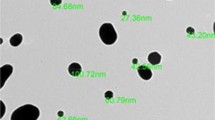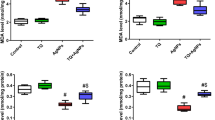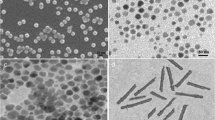Abstract
Silver nanoparticles (Ag-NPs) have various pharmaceutical and biomedical applications owing to their unique physicochemical properties. Zinc (Zn) is an essential trace element, a strong antioxidant, and has a primary role in gene expression, enzymatic reactions, and protein synthesis. The present study aims to explore the toxic effects of Ag-NPs (50 nm) on the liver and kidney of rats and also to evaluate the potential protective effect of Zn-NPs (100 nm) against these adverse effects. Forty adult Sprague–Dawley rats were randomly divided into four equal groups: control group, Ag-NPs group, Zn-NPs group, and Ag-NPs + Zn-NPs group. Ag-NPs (50 mg/kg) and/or Zn-NPs (30 mg/kg) were administered daily by gavage for 90 days. The results showed that exposure to Ag-NPs increased serum ALT, AST, urea, and creatinine. Ag-NPs also induced oxidative stress and lipid peroxidation and increased inflammatory cytokines in hepatic and renal tissues. Moreover, histopathological and immunohistochemical examinations revealed various histological alterations and positive caspase-3 expressions in the liver and kidney following exposure to Ag-NPs. On the other hand, most of these toxic effects were ameliorated by co-administration of Zn-NPs. It was concluded that Ag-NPs have hepatotoxic and nephrotoxic effects in rats via different mechanisms including oxidative stress, inflammation, and apoptosis and that Zn-NPs can be used to alleviate these harmful effects by their antioxidative, anti-inflammatory, and antiapoptotic properties.






Similar content being viewed by others
References
Yusuf M (2018) Silver Nanoparticles: synthesis and applications. In: Handbook of Ecomaterials, pp 2343–2356
Center of Food Safety. Nano-silver in food and food contact products, https://www.centerforfoodsafety.org/files/nanosilver_product_inventory-in-food-12514_66028. Accessed 11 Dec 2017.
Kruszewski M, Brzoska K, Brunborg G et al (2011) Toxicity of silver nanomaterials in higher eukaryotes. Advances in Molecular Toxicology 5:179–218
Prasad RY, McGee JK, Killius MG et al (2013) Investigating oxidative stress and inflammatory responses elicited by silver nanoparticles using high-throughput reporter genes in HepG2 cells: effect of size, surface coating, and intracellular uptake. Toxicol in Vitro 27(6):2013–2021
Xin L, Wang J, Wu Y, Guo S, Tong J (2014) Increased oxidative stress and activated heat shock proteins in human cell lines by silver nanoparticles. Hum Exp Toxicol 34(3):315–323
Lankoff A, Sandberg WJ, Wegierek-Ciuk A, Lisowska H, Refsnes M, Sartowska B, Schwarze PE, Meczynska-Wielgosz S, Wojewodzka M, Kruszewski M (2012) The effect of agglomeration state of silver and titanium dioxide nanoparticles on cellular response in HepG2, A549 and THP-1 cells. Toxicol Lett 208(3):197–213
Lin Z, Monteiro-Riviere NA, Riviere JE (2015) Pharmacokinetics of metallic nanoparticles. Wiley Interdisciplinary Reviews: Nanomedicine and Nanobiotechnology 7:189–217
Choia JE, Kima S, Ahna JH et al (2010) Induction of oxidative stress and apoptosis by silver nanoparticles in the liver of adult zebrafish. Aquat Toxicol 100(2):151–159
Gaiser BK, Hirn S, Kermanizadeh A, Kanase N, Fytianos K, Wenk A, Haberl N, Brunelli A, Kreyling WG, Stone V (2013) Effects of silver nanoparticles on the liver and hepatocytes in vitro. Toxicol Sci 131(2):537–547
Korani M, Rezayat SM, Bidgoli SA (2013) Sub-chronic dermal toxicity of silver nanoparticles in guinea pig: special emphasis to heart, bone and kidney toxicities. Iranian Journal of Pharmaceutical Research 12(3):511–519
Park EJ, Bae E, Yi J, Kim Y, Choi K, Lee SH, Yoon J, Lee BC, Park K (2010) Repeated-dose toxicity and inflammatory responses in mice by oral administration of silver nanoparticles. Environ Toxicol Pharmacol 30(2):162–168
Sardari RRR, Zarchi SR, Talebi A et al (2012) Toxicological effects of silver nanoparticles in rats. Afr J Microbiol Res 6(27):5587–5593
Kouame K, Peter AI, Akang EN et al (2018) Effect of long-term administration of cinnamomum cassia silver nanoparticles on organs (kidneys and liver) of Sprague-Dawley rats. Turk J Biol 42(6):498–505
Pasquet J, Chevalier Y, Couval E, Bouvier D, Noizet G, Morlière C, Bolzinger MA (2014) Antimicrobial activity of zinc oxide particles on five micro-organisms of the Challenge Tests related to their physicochemical properties. Int J Pharm 460(1-2):92–100
Mielcarz-Skalska L, Smolińska B (2017) Zinc and nano-ZnO – influence on living organisms. Biotechnol Food Sci 81(2):93–102
Ho E (2004) Zinc deficiency, DNA damage and cancer risk. J Nutr Biochem 15(10):572–578
Rasmussen JW, Martinez E, Louka P, Wingett DG (2010) Zinc oxide nanoparticles for selective destruction of tumor cells and potential for drug delivery applications. Expert Opin Drug Deliv 7(9):1063–1077
Dawei AI, Zhisheng W, Angu Z (2009) Protective effects of nano-ZnO on the primary culture mice intestinal epithelial cells in in vitro against oxidative injury. J Anim Vet Adv 8(10):1964–1967
Saddick S, Afifi M, Abu Zinada OAA (2017) Effect of zinc nanoparticles on oxidative stress-related genes and antioxidant enzymes activity in the brain of Oreochromis niloticus and Tilapia zillii. Saudi Journal of Biological Science 24(7):1672–1678
Raajshreer KR, Durairaj B (2017) Evaluation of the anti-tyrosinase and antioxidant potential of zinc oxide nanoparticles synthesized from the brown seaweed – Turbinaria conoides. Int J Appl Pharm 9(5):116–120
Essa SS, El-Saied EM, El-Tawil OS, Gamal IM, Abd EL-Rahman SS (2019) Nanoparticles of zinc oxide defeat chlorpyrifos-induced immunotoxic effects and histopathological alterations. Vet World 12(3):440–448
Bashandy SAE, Alaamer A, Moussa SAA, Omara EA (2018) Role of zinc oxide nanoparticles in alleviating hepatic fibrosis and nephrotoxicity induced by thioacetamide in rats. Can J Physiol Pharmacol 96(4):337–344
Atef HA, Mansour MK, Ibrahim EM, Sayed el-Ahl RMH, al-Kalamawey NM, el Kattan YA, Ali MA (2016) Efficacy of zinc oxide nanoparticles and curcumin in amelioration the toxic effects in aflatoxicated rabbits. Int J Curr Microbiol App Sci 5(12):795–818
Kim YR, Park JI, Lee EJ et al (2014) Toxicity of 100 nm zinc oxide nanoparticles: a report of 90-day repeated oral administration in Sprague Dawley rats. Int J Nanomedicine 9(2):109–126
Lee PC, Meisel D (1982) Adsorption and surface-enhanced Raman of dyes on silver and gold sols. J Phys Chem 86:3391–3395
Tejamaya M, Romer I, Merrifield RC, Lead JR (2012) Stability of citrate, PVP, and PEG coated silver nanoparticles in ecotoxicology media. Environ Sci Technol 46(13):7011–7017
Kim YS, Song MY, Park JD et al (2010) Subchronic oral toxicity of silver nanoparticles. Particle and Fibre Toxicol 7(1):1–11
Bancroft JD, Gamble M (2008) Theory and practice of histological techniques, 6th edn. Elsevier, Churchill Livingstone
Hsu SM, Raine L, Fanger H (1981) The use of antiavidin antibody and avidin-biotin peroxidase complex in immunoperoxidase techniques. Am J Clin Pathol 75(6):816–821
Huang XJ, Choi YK, Im HS, Yarimaga O, Yoon E, Kim HS (2006) Aspartate aminotransferase (AST/GOT) and alanine aminotransferase (ALT/GPT) detection techniques. Sensors 6(7):756–782
Gowda S, Desai PB, Kulkarni SS, Hull VV, Math AAK, Vernekar SN (2010) Markers of renal function tests. N Am J Med Sci 2(4):170–173
Piao MJ, Kang KA, Lee IK, Kim HS, Kim S, Choi JY, Choi J, Hyun JW (2011) Silver nanoparticles induce oxidative cell damage in human liver cells through inhibition of reduced glutathione and induction of mitochondria-involved apoptosis. Toxicol Lett 201(1):92–100
Ma W, Jing L, Valladares A, Mehta SL, Wang Z, Li PA, Bang JJ (2015) Silver nanoparticle exposure induced mitochondrial stress, caspase-3 activation and cell death: amelioration by sodium selenite. Int J Biol Sci 11(8):860–867
Cheraghi J, Hosseini E, Hoshmandfar R, Sahraei R, Farmany A (2013) In vivo effect of silver nanoparticles on serum ALT, AST and ALP activity in male and female mice. Australian Journal of Basic and Applied Sciences 7(1):171–177
Nasir GA, Samir HF, Mohammed AK (2015) Effects of silver nanoparticles in liver function enzymes and oxidative stress levels. World Journal of Pharmaceutical Research 4(9):2080–2989
Abdel-Wahhab MA, Ahmed H, El-Nekeety AA et al (2020) Chenopodium murale essential oil alleviates the genotoxicity and oxidative stress of silver nanoparticles in the rat kidney. Egypt J Chem 63(7):2631–2646
Rani V, Verma Y, Rana K, Rana SVS (2018) Zinc oxide nanoparticles inhibit dimethylnitrosamine induced liver injury in rat. Chem Biol Interact 295:84–92
Hassan I, Husain FM, Khan RA, Ebaid H, al-Tamimi J, Alhazza IM, Aman S, Ibrahim KE (2019) Ameliorative effect of zinc oxide nanoparticles against potassium bromate-mediated toxicity in Swiss albino rats. Environ Sci Pollut Res 26(10):9966–9980
Dinarello CA (2000) Proinflammatory cytokines. Chest 118(2):503–508
Noshy PA, Azouz RA (2021) Neuroprotective effect of hesperidin against emamectin benzoate-induced neurobehavioral toxicity in rats. Neurotoxicol Teratol 86:106981
Nel A, Xia T, Mädler L, Li N (2006) Toxic potential of materials at the nanolevel. Science 311(5761):622–627
Bressan E, Ferroni L, Gardin C, Rigo C, Stocchero M, Vindigni V, Cairns W, Zavan B (2013) Silver nanoparticles and mitochondrial interaction. Int J Dent 2013:312747
Abd El-Maksoud EM, Lebda MA, Hashem AE, Taha NM, Kamel MA (2019) Ginkgo biloba mitigates silver nanoparticles-induced hepatotoxicity in Wistar rats via improvement of mitochondrial biogenesis and antioxidant status. Environ Sci Pollut Res 26(25):25844–25854
Shehata AM, Salem FMS, El-Saied EM, Abd El-Rahman SS, Mahmoud MY, Noshy PA (2021) Zinc nanoparticles ameliorate the reproductive toxicity induced by silver nanoparticles in male rats. Int J Nanomedicine 16:2555–2568
Ranjbar A, Firozian F, Soleimani Asl S, Ghasemi H, Taheri Azandariani M, Larki A, Kheiripour N, Hosseini A, Naserabadi A (2018) Nitrosative DNA damage after sub-chronic exposure to silver nanoparticle induces stress nephrotoxicity in rat kidney. Toxin Rev 37(4):327–333
Nishanth RP, Jyotsna RG, Schlager JJ, Hussain SM, Reddanna P (2011) Inflammatory responses of RAW 264.7 macrophages upon exposure to nanoparticles: role of ROS-NFκB signaling pathway. Nanotoxicology 5(4):502–516
Tiwari R, Singh RD, Khan H, Gangopadhyay S, Mittal S, Singh V, Arjaria N, Shankar J, Roy SK, Singh D, Srivastava V (2017) Oral subchronic exposure to silver nanoparticles causes renal damage through apoptotic impairment and necrotic cell death. Nanotoxicology 11(5):671–686
Suntres ZE, Lui EMK (1990) Biochemical mechanism of metallothionein–carbon tetrachloride interaction in vitro. Biochem Pharmacol 39(5):833–840
Parat MO, Richard MJ, Béani JC, Favier A (1997) Involvement of zinc in intracellular oxidant/antioxidant balance. Biol Trace Elem Res 60(3):187–204
Bao B, Ahmad A, Azmi A, Li Y, Prasad A, Sarkar FH (2013) The biological significance of zinc in inflammation and aging. In: Inflammation, advancing age and nutrition: research and clinical interventions, 1st edn. Elsevier, New York, pp 15–27
Wessels I, Haase H, Engelhardt G, Rink L, Uciechowski P (2013) Zinc deficiency induces production of the proinflammatory cytokines IL-1β and TNFα in promyeloid cells via epigenetic and redox-dependent mechanisms. J Nutr Biochem 24(1):289–297
Jänicke RU, Sprengart ML, Wati MR, Porter AG (1998) Caspase-3 is required for DNA fragmentation and morphological changes associated with apoptosis. J Biol Chem 273(16):9357–9360
Sulaiman FA, Adeyemi OS, Akanji MA, Oloyede HOB, Sulaiman AA, Olatunde A, Hoseni AA, Olowolafe YV, Nlebedim RN, Muritala H, Nafiu MO, Salawu MO (2015) Biochemical and morphological alterations caused by silver nanoparticles in Wistar rats. Journal of Acute Medicine 5(4):96–102
Hussain SM, Hess KL, Gearhart JM, Geiss KT, Schlager JJ (2005) In vitro toxicity of nanoparticles in BRL 3A rat liver cells. Toxicol in Vitro 19(7):975–983
Hsin YH, Chen CF, Huang S, Shih TS, Lai PS, Chueh PJ (2008) The apoptotic effect of nanosilver is mediated by a ROS-and JNK-dependent mechanism involving the mitochondrial pathway in NIH3T3 cells. Toxicol Lett 179(3):130–139
Singh SP, Bhargava CS, Dubery V, Mishra A, Singh Y (2017) Silver nanoparticles: biomedical applications, toxicity, and safety issues. International Journal of Research in Pharmacy and Pharmaceutical Sciences 4(2):01–10
Hussein R, Sarhan O (2014) Effects of intraperitoneally injected silver nanoparticles on histological structures and blood parameters in the albino rat. Int J Nanomedicine 9:1505–1517
Ahmadian E, Dizaj SM, Rahimpour E, Hasanzadeh A, Eftekhari A, Hosain zadegan H, Halajzadeh J, Ahmadian H (2018) Effect of silver nanoparticles in the induction of apoptosis on human hepatocellular carcinoma (HepG2) cell line. Mater Sci Eng C 93:465–471
Hambidge KM, Krebs NF (2007) Zinc deficiency: a special challenge. J Nutr 137(4):1101–1105
Funding sources
This research work was financially supported by Cairo University.
Author information
Authors and Affiliations
Corresponding author
Ethics declarations
Conflicts of interest
The authors declare no competing interests.
Additional information
Publisher’s Note
Springer Nature remains neutral with regard to jurisdictional claims in published maps and institutional affiliations.
Rights and permissions
About this article
Cite this article
Shehata, A.M., Salem, F.M.S., El-Saied, E.M. et al. Evaluation of the Ameliorative Effect of Zinc Nanoparticles against Silver Nanoparticle–Induced Toxicity in Liver and Kidney of Rats. Biol Trace Elem Res 200, 1201–1211 (2022). https://doi.org/10.1007/s12011-021-02713-2
Received:
Accepted:
Published:
Issue Date:
DOI: https://doi.org/10.1007/s12011-021-02713-2




